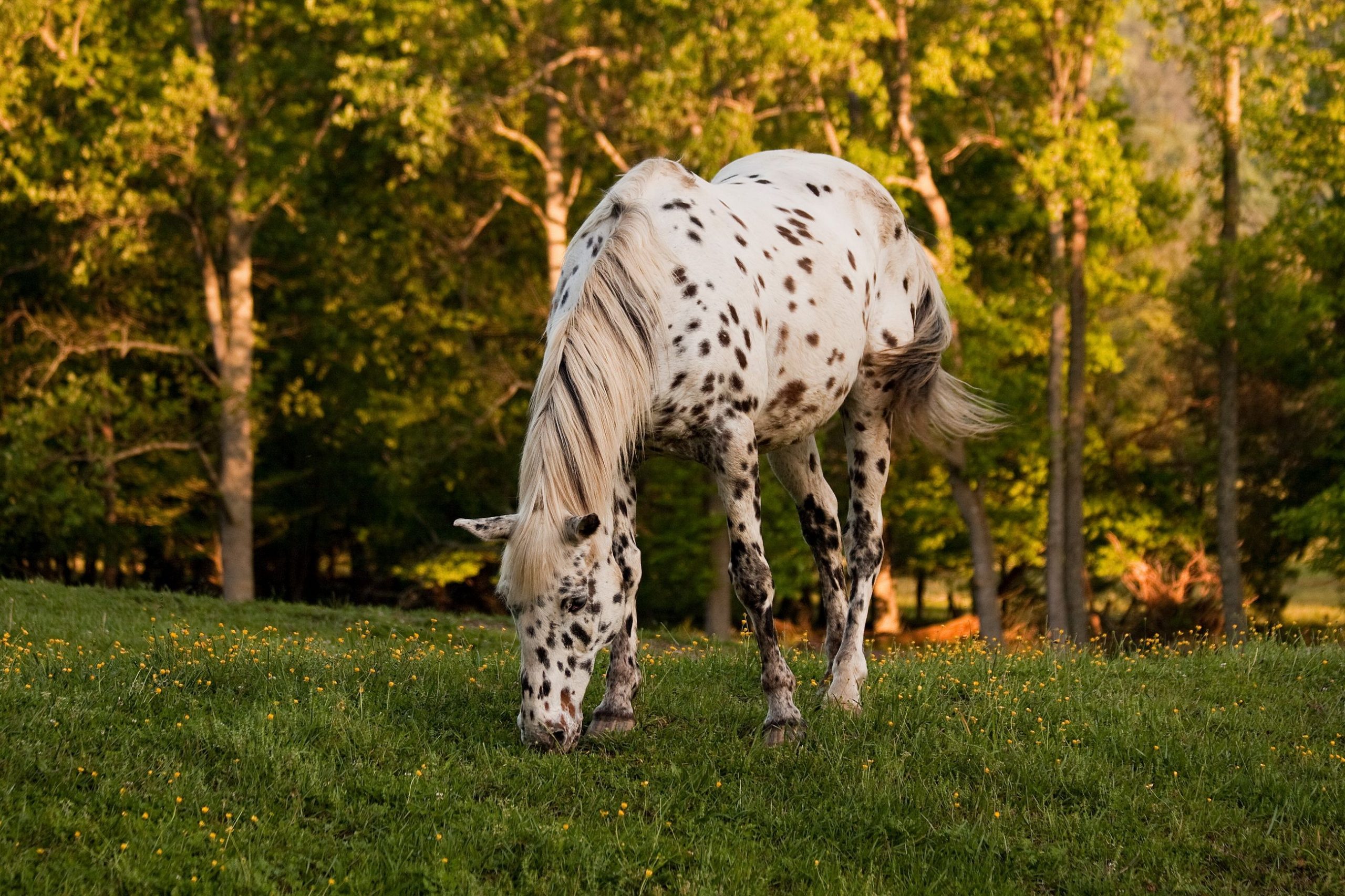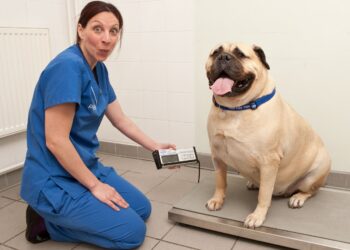There is summer, good weather and… sunburn! They are far from being a piece of cake: anyone who has exposed themselves a little too long on the beach without having properly protected their skin knows something about it. We humans sometimes think we are the only ones who can get it; but no, our equine friends can too, despite their fur.
Their scaly, pink noses are sure proof! So what do you need to know about sunburn in horses? What are the causes? First, how to recognize them: are they visually identical to human sunburn? What to do when your horse has a sunburn? What are the treatments? We will end with an overview of the possibilities of prevention. We wish you a very good reading!
Do Horses Also Get Sunburn?
While many riders put on sunscreen when out on a horseback ride in strong sun, they tend to underestimate the same risk from sunburn in their equine companion. After all, horses have coats: nature must have foreseen that, right?
Unfortunately, their hair does not always offer a sufficient level of protection against UV-A and UV-B rays. What are UV-Bs, will you tell me? It is the short-wave rays responsible for tanning in humans; they are also important for the formation of vitamin D. On the other hand, in horses, the majority of sunburns of our dear quadrupeds are attributable to them!
There are also UV-A rays: these are long waves reaching the deeper layers of the skin, precisely down to the dermis. They are involved in the formation of sunburn, and can also promote skin cancer.
Reading Suggestion: 501+ Horse Names For Male and Female Horse Names
What Causes Sunburn In Horses?
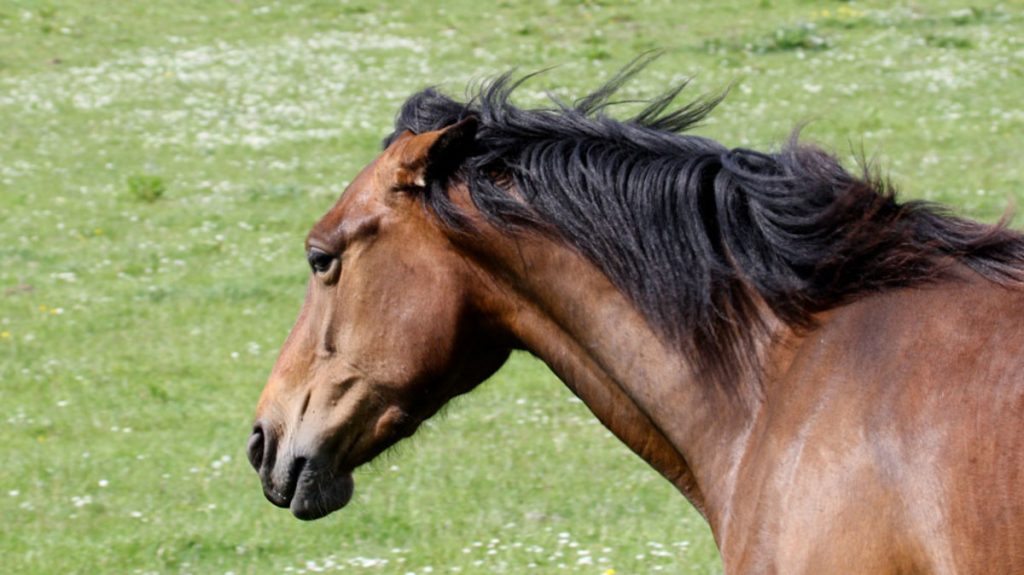
Sunburn occurs, as you know, after too long exposure to the sun. But certain factors increase the risk of sunburn: we are going to talk about photosensitization.
Beware Of Photosensitization
Certain plants increase the risk of sunburn in a horse. Our dear companions being exclusive herbivores, we must pay attention to the type of plants they ingest: for example, alfalfa, buckwheat, or even St. John’s wort contain photosensitizing substances which can make their skin more sensitive to the sun: we then speak of photosensitivity.
Reading Suggestions: Atypical Myopathy in Horses
It does not apply to all horses; some are not prone to it, but insensitive horses, it can lead to primary photo-dermatitis: this skin disease is either triggered by light by the ingestion or injection of a photosensitizing substance, or by direct absorption of the latter by the skin. In severe cases, it can even affect darker areas of the skin.
A horse can also suffer from secondary photo-dermatitis, metabolic this time: a photosensitizing substance then accumulates in its plasma, its liver no longer being able to break down a product of degradation of chlorophyll.
In this particular case, this overdosed substance also causes increased susceptibility to sunburn. Plants that drive this metabolic form are buttercups, ragworts, and hybrid clover. However, to be sure, you can have your horse tested to see if its liver values are normal.
So pay attention to your horse’s diet and be careful to exclude risky plants from its diet.
What Types Of Horses Are Most Affected?
Many horse owners believe that only white or light-colored horses are at risk. But it’s wrong! Underneath their coat, a significant portion of light- or gray-coated equines actually have dark, almost black skin that absorbs the sun’s rays and filters out harmful UV rays.
Thus horses with light, gray, or spotted coats are as much at risk as their colleagues with black coats, chestnuts, or bays. And where foals had spots, later, as adults, these horses will show pink-colored skin under the coat in those specific places, which is particularly at risk for sunburn.
White or light blue-eyed horses are often referred to as albinos in common parlance. But this type of horse is called in specialized language Cremello, Perlino, or Smokey Cream.
The name Albinos is nothing more than a term applied to the human species which was wrongly taken for horses! It is the Crème gene that is responsible for the appearance of this type of horse, through a double inheritance. And these horses are indeed particularly susceptible to sunburn!
How To Recognize Sunburn In Horses?
Wondering how to identify a sunburn in your pet? Here is a description of the most common symptoms.
Classic Symptoms
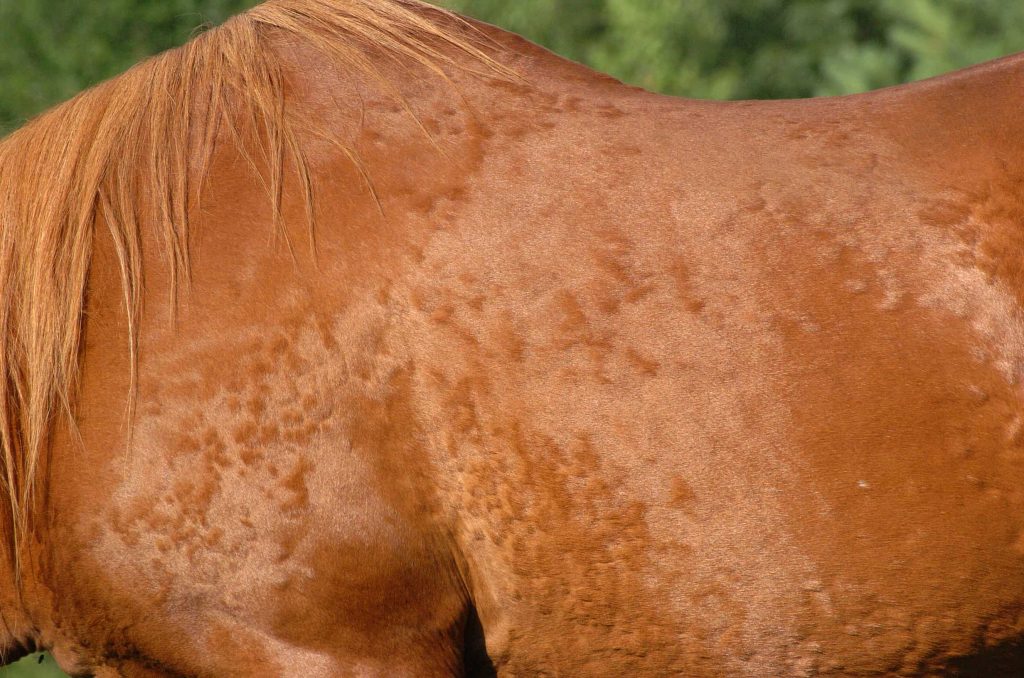
When sunburned, the horse’s skin does not turn bright red like humans but tends to swell and is painful. It looks like mud fever that you may know in winter. Scabs then appear, which, if removed, leave oozing areas of skin, which heal poorly.
In more severe cases, you will observe the formation of small blisters. If you have inadvertently failed to notice your horse’s sunburn, and continue to expose it to the sun, then the affected areas will expand and become inflamed. Its members can even become real posts and the scabs real wounds, which can lead to lameness.
Depending on the sensitivity of his skin, the intensity of solar radiation, and the duration of exposure to the sun, the burn of his skin can be more or less serious. In the case of solar dermatitis (sunburn), unlike a thermal burn caused by intense heat, erythema will form, usually after 3 to 5 hours. It generally reaches its maximum after 12 to 24 hours.
Pay attention to the water when swimming, among other things: it acts as a factor that increases the risk of sunburn. Pay attention to the first signs: by reacting quickly, you will avoid a real hassle.
3 Levels Of Severity
Below is a classification of sunburns according to their severity. They can be classified into three distinct categories:
- Superficial sunburn with slight skin redness and pain.
- Severe sunburn with strong redness, formation of blisters, possible inflammation by bacteria, intense pain.
- Severe sunburn with destruction or even detachment of the skin over an extended surface, the possibility of a major inflammatory reaction with secondary bacterial infection and fever. Severe pain.
On Which Body Areas Do They Appear Most Frequently?
Some areas of the body are much more prone than others to sunburn, in particular areas of pink skin, less pigmented and less hairy… The following areas of the body are particularly concerned:
Protect the areas mentioned above from the sun as much as possible and watch them carefully because the risk of sunburn is higher there than elsewhere.
What To Do In Case Of Sunburn In The Horse?
The first action to take is a simple rule of common sense: put your horse in the shade. This measure seems basic, and yet many owners leave their sunburned horse in an unsheltered place in the meadow under a blazing sun…
Then it is a matter of cooling the affected areas with damp cloths and cold water. However, be careful, do not use frozen water or an ice pack!
In addition, the horse’s water needs tend to be greater when affected by sunburn. Particularly if your companion is hit in the muzzle, the pain is such that it may have difficulty getting water: in such conditions, do not hesitate to give it a drink directly from a basin or bucket. , until the pain subsides.
In addition, if it is affected at the level of the muzzle, the relatively hard stalks of hay or straw can make it difficult for it to feed. In this case, try to choose a more tender and soft type, or opt for soaked hay pellets; you will see, it will be easier for him!
How To Treat Sunburn In Horses?
Clean and Dry
Once you have cooled the affected areas of the skin, it is then advisable to clean the limbs with mild antiseptic soap (sunburns are often at this level), lathering the product well and leaving it to act for some time. Then, wash them with clear water and then dry each area individually: ideally with old clean towels to separate each affected area (there are 4 patterns and 4 times two sides of balls or limbs).
This way, you’ll avoid spreading bacterial infection from one area to another and speed healing. Above all, don’t tear off the scabs: if they fall off on their own, fine, but don’t force the movement; gently pat the sensitive area dry. Then apply a regenerating cream or care product to the affected area.
Apply A Regenerating Cream
The goal here is to promote the regeneration of the skin. To this end, avoid any type of cream or preparation containing fat: in fact, these can hinder the dissipation of the sensation of heat from the burned skin, or even intensify any inflammatory reactions.
In case of the affected area in a limited way, presenting small crusts, you can use a protective and moisturizing cream which is also healing. In more serious cases, you can apply Predniderm, a cream that is both anti-inflammatory and antibiotic: it acts as a support treatment for superficial wounds and helps to promote the natural protective function of the skin.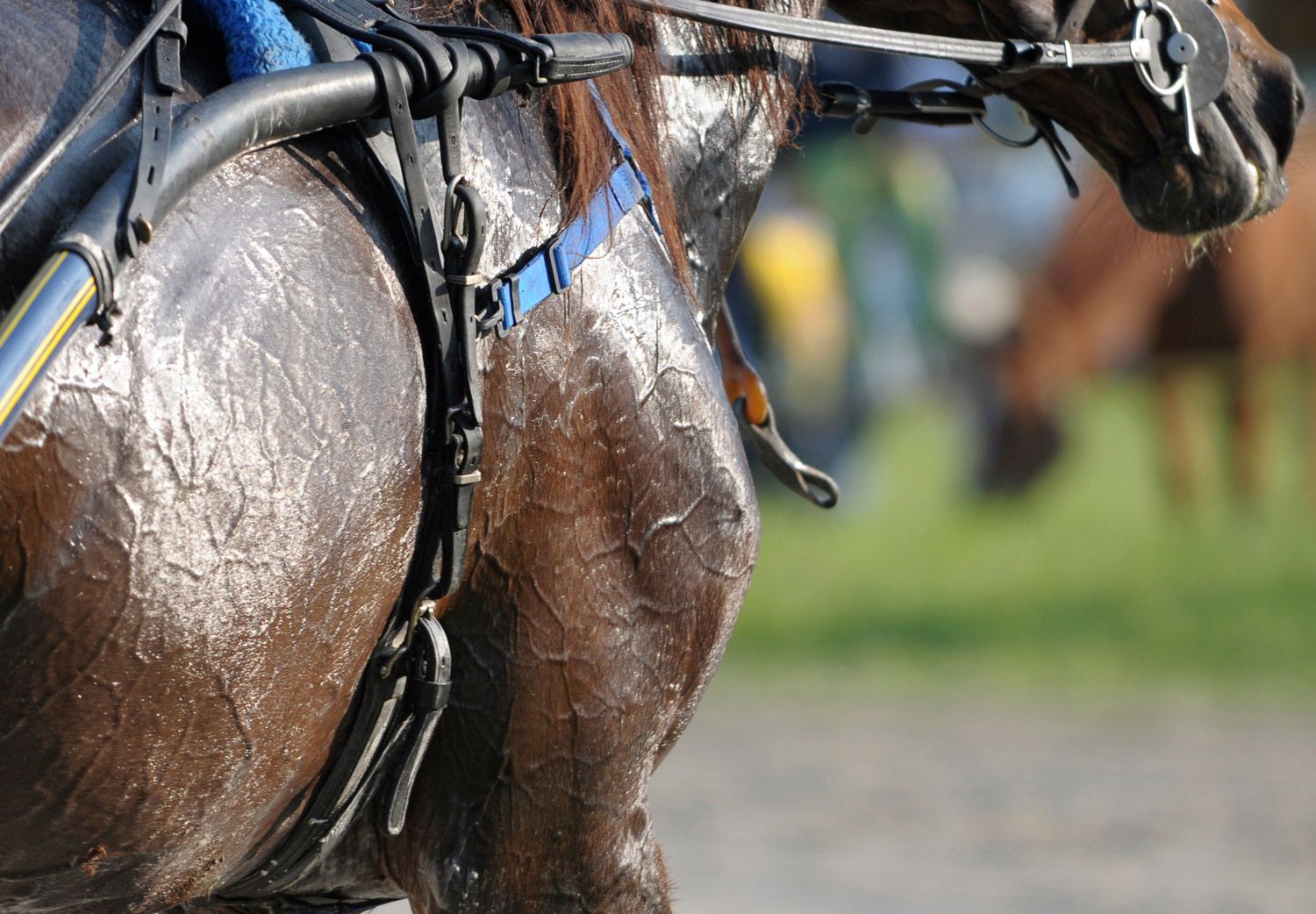
And in much more serious cases, in the presence of voluminous scabs, of a more extensive infection, or if the limbs look like real poles, you should consult your veterinarian and seek his advice. There are some stronger, prescription-only creams like Sulmidol or Mastijet that are more suitable for heavier cases.
How To Prevent Sunburn In Horses?
Stay In A Shady Place
The easiest way to prevent sunburn in your horse is to simply not expose it to it! To do this, always provide some shaded areas in the meadow: a row of trees or a small shelter where he can protect himself from the sun’s rays. Otherwise, plan short walks in the paddock, ideally in the morning or evening: this way, it will not be exposed to the strongest hours of sunshine… Some even choose to leave their horses in the stables during the day and take them out at night.
In addition, a walk in the forest is a good idea to escape the blazing sun and afford some freshness, both for the rider and for his mount.
Sun Cream For Sunburn In Horses
For a higher level of protection, you can administer, on the areas at risk, sunscreen specially designed for horses. Be careful in all cases to choose a sunscreen that is free of grease (and which could stick to its coat), fragrance-free (a horse has a sensitive nose; an unpleasant smell could be problematic for him), and without preservatives.
Some even choose children’s sunscreen. However, a single application before going out to the paddock is generally not sufficient: several daily applications on light areas or areas with pink skin are necessary to obtain sufficient protection; to do this, prefer a sunscreen with a minimum index of 30. So yes, it has a certain cost, but your horse’s health is at stake! Our advice:
Fly Mask, Uv Blanket, And Other Protections
Some additional equipment can also make your life easier!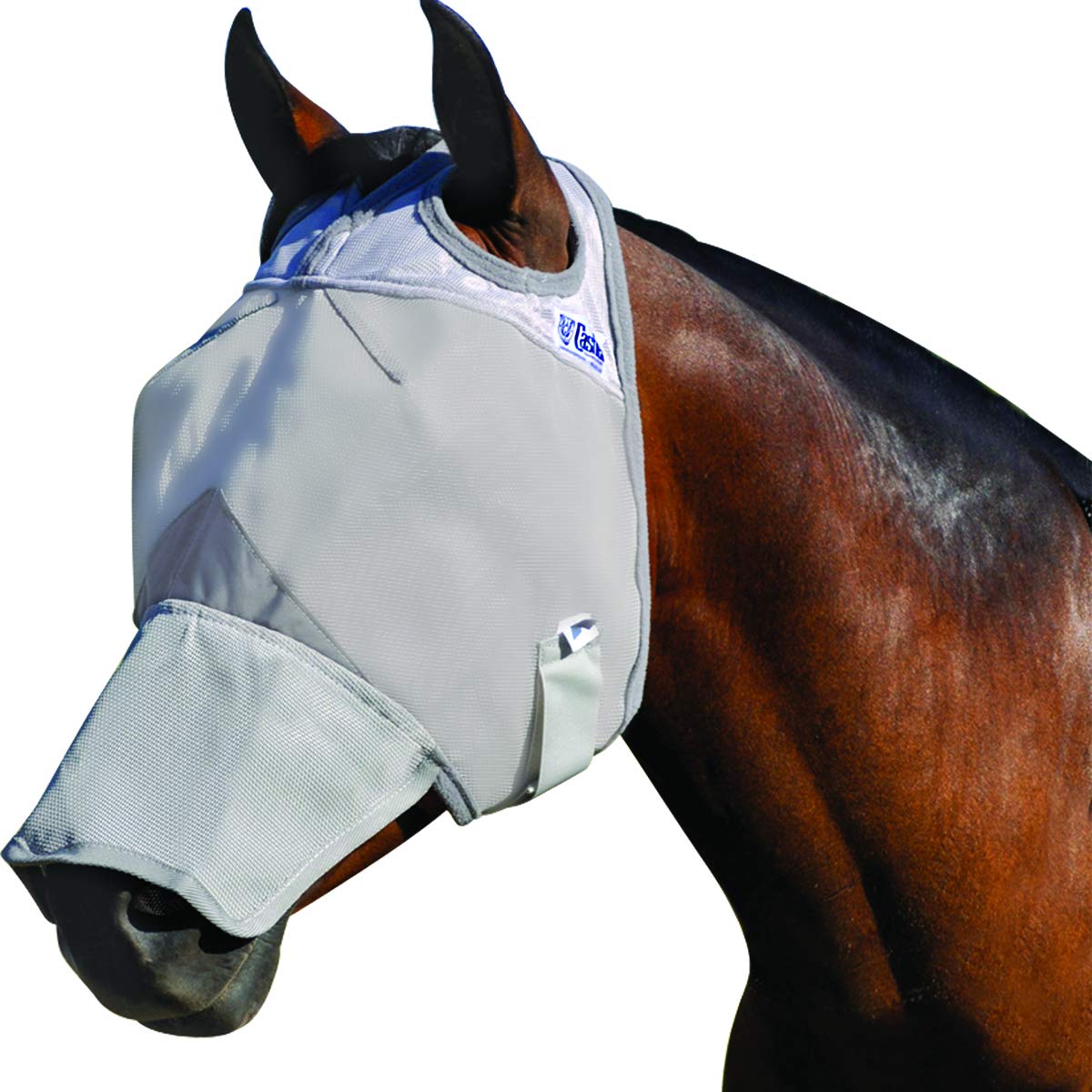
Protective masks can be useful to protect the nostrils and the area around the mouth during a walk largely out of the woods. There are also fly masks (anti-fly masks) and anti-UV including a very effective nose guard and which offer complete protection of the horse’s head; some even have a built-in nose net providing UV protection from the top of his nose to the tips of his ears.
Reading Suggestion: Horse blanket: when it is useful for equine health
And if you want full body protection for a horse with sensitive or poorly pigmented skin, you can opt for a UV protection shirt or blanket that protects the animal’s entire body, from head to tail. These solar blankets are generally quite light, pale in color, and are designed in such a way that the animal does not sweat disproportionately under the blazing sun…
Finally, there are also neoprene hoof protectors that protect the fold of the pastern against burns, as sunscreen does not stick well there.
Conclusion
Be careful, because once your horse is affected, it is very difficult to cure his sunburn. The advice is, therefore, as much as possible, to respect the various preventive measures that we have recommended in this article… Believe us, your horse will be delighted! Another tip: watch out for plants that can cause photosensitization.
So keep an eye on your horse’s diet to limit the risks associated with increased susceptibility to sunburn. However, don’t forget the essentials: take advantage of horseback riding as much as possible this summer, while remaining careful to adapt to the places and times of the walk according to the sunshine and the ambient heat.


